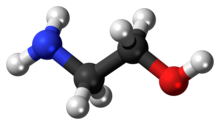에탄올아민
화합물
에탄올아민(Ethanolamine)은 화학식 HOCH
2CH
2NH
2 또는 C
2H
7NO를 갖는 유기 화합물이다.[8] 이 분자는 일차 아민과 일차 알코올을 동시에 함유하는 이기작용성 분자이다. 에탄올아민은 무색의 점성이 있는 액체이며 암모니아 냄새가 난다.

| |

| |
| 이름 | |
|---|---|
| 우선명 (PIN)
2-Aminoethan-1-ol[1] | |
별칭
| |
| 식별자 | |
3D 모델 (JSmol)
|
|
| ChEBI | |
| ChEMBL | |
| ChemSpider | |
| DrugBank | |
| ECHA InfoCard | 100.004.986 |
| EC 번호 |
|
| KEGG | |
PubChem CID
|
|
| RTECS 번호 |
|
| UNII | |
CompTox Dashboard (EPA)
|
|
| |
| |
| 성질 | |
| C2H7NO | |
| 몰 질량 | 61.084 g·mol−1 |
| 겉보기 | Viscous colourless liquid |
| 냄새 | Unpleasant ammonia-like odour |
| 밀도 | 1.0117 g/cm3 |
| 녹는점 | 10.3 °C (50.5 °F; 283.4 K) |
| 끓는점 | 170 °C (338 °F; 443 K) |
| Miscible | |
| 증기 압력 | 64 Pa (20 °C)[2] |
| 산성도 (pKa) | 9.50[3] |
굴절률 (nD)
|
1.4539 (20 °C)[4] |
| 위험 | |
| 물질 안전 보건 자료 | Sigma[5] |
| GHS 그림문자 |  
|
| 신호어 | 위험 |
| H302, H312, H332, H314, H335, H412[5] | |
| P261, P273, P305+351+338, P303+361+353[5] | |
| NFPA 704 (파이어 다이아몬드) | |
| 인화점 | 85 °C (185 °F; 358 K) (closed cup) |
| 410 °C (770 °F; 683 K) | |
| 폭발 한계 | 5.5–17% |
| 반수 치사량 또는 반수 치사농도 (LD, LC): | |
LD50 (median dose)
|
|
| NIOSH (미국 건강 노출 한계): | |
PEL (허용)
|
TWA: 3 ppm (6 mg/m3)[6] |
REL (권장)
|
|
IDLH (직접적 위험)
|
30 ppm[6] |
| 관련 화합물 | |
관련 화합물
|
|
달리 명시된 경우를 제외하면, 표준상태(25 °C [77 °F], 100 kPa)에서 물질의 정보가 제공됨.
| |
산업 생산
편집생합성
편집- HOCH
2CH(CO
2H)NH
2 → HOCH
2CH
2NH
2 + CO2
각주
편집- ↑ 가 나 《Nomenclature of Organic Chemistry : IUPAC Recommendations and Preferred Names 2013 (Blue Book)》. Cambridge: The Royal Society of Chemistry. 2014. 649, 717쪽. doi:10.1039/9781849733069-FP001. ISBN 978-0-85404-182-4.
For example, the name ‘ethanolamine’, which is still widely used, is badly constructed because of the presence of two suffixes; it is not an alternative to the preferred IUPAC name, ‘2-aminoethan-1-ol’.
- ↑ “Ethanolamine MSDS” (PDF). Acros Organics. 2011년 7월 15일에 원본 문서 (PDF)에서 보존된 문서.
- ↑ Hall, H.K. (1957). “Correlation of the Base Strengths of Amines”. 《J. Am. Chem. Soc.》 79 (20): 5441–4. doi:10.1021/ja01577a030.
- ↑ Reitmeier, R.E.; Sivertz, V.; Tartar, H.V. (1940). “Some Properties of Monoethanolamine and its Aqueous Solutions”. 《Journal of the American Chemical Society》 62 (8): 1943–44. doi:10.1021/ja01865a009.
- ↑ 가 나 다 Sigma-Aldrich Co. Retrieved on 2018-05-24.
- ↑ 가 나 다 NIOSH Pocket Guide to Chemical Hazards. “#0256”. 미국 국립 직업안전위생연구소 (NIOSH).
- ↑ “Ethanolamine”. 《Immediately Dangerous to Life and Health Concentrations (IDLH)》. National Institute for Occupational Safety and Health (NIOSH).
- ↑ “National Library of Medicine. PubChem. Ethanolomine.”. 《NIH, National Library of Medicine》. 2021년 9월 5일에 확인함.
